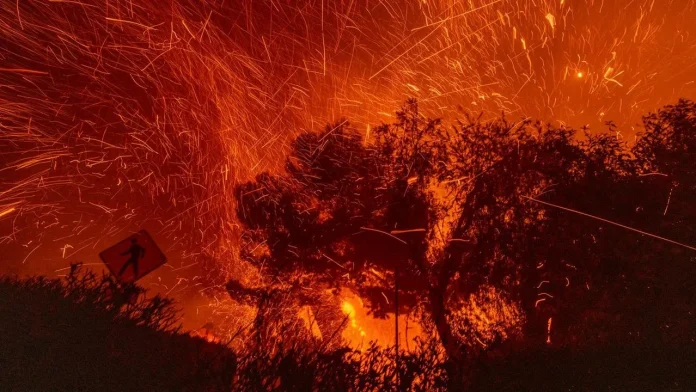The recent spate of wildfires that ravaged California has brought many challenges to residents, schools, and the local authorities. School closures have immediately become a necessity since fires like the Eaton and Palisades fires have caused high degrees of destruction. This article gives an overview of school closures in Los Angeles and its vicinity, the reasons behind those closures, and measures being taken towards affected communities.
The Date of School Closures
Wildfires and Gusty Winds Cause School Shutdowns
Wildfires and gusty winds have closed almost two dozen school districts in Los Angeles County, shutting down schools completely or partially. The school closures began on January 7, 2025, and persisted throughout the spreading fires, producing dangerous air quality and travel conditions. Among the hardest hit are the Los Angeles Unified, where several campuses were destroyed or partially destroyed by the fires.
Reopening Efforts in Affected School Districts
While some school districts, including Azusa Unified and Baldwin Park Unified, begin to reopen today, others such as Glendale Unified and Pasadena Unified announced closings through the end of the week. This close of the school shows how important this event is and why it should be taken seriously as it is going to affect a lot of lives. It shows the diversity of conditions around the region where districts are reviewing damage and assessing safety.
also read: Teladoc Offers Free Virtual Care to Help During Los Angeles Wildfires
Resons Behind School Closures
The primary reasons behind these closures include poor air quality, high winds, and general safety hazards. For example:
- Alhambra Unified: Superintendent Denise Jaramillo said some of the issues were poor air quality as well as staffing shortages due to mandatory evacuation orders.
- Arcadia Unified: The district highlighted the issue of campus security, citing that it means to keep its emergency communication channels open with the families.
- LAUSD: Superintendent Alberto Carvalho pointed out hazardous conditions, adding that smoke and debris were being blown into communities.
The unpredictability of the fires, mostly driven by high winds, has made it hard for districts to plan. Many have opted for closures to ensure that students and staff are not exposed to such harmful conditions.
Effects of Fire on Students and Staff
The fires have thrown off the routines of thousands of students and staff. Palisades Charter Elementary and Marquez Charter Elementary are completely destroyed, displacing students who now have to move. Many members of the staff live in evacuation zones or lost property in the fires.
San Marino Unified Superintendent Linda de la Torre reported that 60% of her district’s workforce is either directly impacted by evacuation orders or other challenges, which makes some districts unable to operate safely with such impacts.
Support for Students and Families
Many school districts are taking several actions to support their students and their families during this crisis:
Distribution of Meals
Many school districts are providing grab-and-go meals so the children receive food. For example, LAUSD has provided distribution sites at South Gate High School and Mulholland Middle School.
Mental Health Help:
LAUSD has provided a resource line for student and family wellness, and employees have the Employee Assistance Service for Education (EASE).
Intramural Safety:
Districts like Rosemead Unified installed air filter systems in class and reduced activity periods outdoors so the students reduce being affected more.
Also read: California Fires Map: Palisades & Eaton Fire Updates
Continuation of Learning :
Preparations by some for extended closure might have led to online sessions. LAUSD expects to finalize arrangements on possible online class updates to be declared before January 10.
Disruption in Schools Opening
While districts like Azusa Unified have begun reopening, there are still obstacles. For example, power outages, damaged facilities, and hazardous conditions haunt many districts, delaying their reopening. For example;
Bonita Unified Schools- While most schools have reopened, three campuses are yet to reopen because of some problems with the power supply.
Glendora Unified- While they did their best by fixing the malfunctioning power supply coupled with communication systems, the district cannot reopen.
Charter Schools and Private Institutions are Closed
Charter schools in the region also experienced a devastating effect. Over 70 charter schools, which include Alliance College-Ready Public Schools and Bright Star Schools, remain shut down. And, the shutting down of schools has brought a kind of relaxation for the student but at the same time, it is alarming. Four campuses of Green Dot Public Schools declared closure as well, showing just how devastating the fires were to different levels and forms of schools.
Community Resilience and Recovery
Although destruction prevails, the communities are trying to unite to help each other. Districts such as La Cañada Unified have assured that they would rebuild and care for families during this challenging period.
In Pasadena Unified, Superintendent Elizabeth Blanco recognized the fact that some time is required to regain normalcy and urged the families to stay strong as the district examines conditions. People are trying hard and recent days have shown the chance of improvement.
Also read: Karen Bass and the Los Angeles Wildfires: Leadership Response
Future Plans and Uncertainty
Since the fires are ongoing, many school districts operate on a day-by-day basis, closing when the fires erupt or air quality worsens. Santa Monica-Malibu Unified is gathering resources for families and will decide whether to extend the shutdown by January 9.
A Call to Action
Going beyond education, these school closures do highlight the importance of more robust disaster preparedness and community support systems. As the schools try to recover, it’s a role that public media organizations like LAist continue making headlines, relying on support from people such that indispensable reporting is maintained.
Conclusion
It is still a tough and hazardous climate for school districts statewide with the fires raging in California. Closures to community support initiatives show a commitment to putting safety first in navigating unprecedented challenges.
As fires continue to rage, resilience and cooperation on the part of students, staff, and families seem to offer a glimmer of hope for recovery. Whether through meal distributions, mental health support, or eventual rebuilding efforts, such actions highlight unity in times of crisis. All in all, this climate is very dangerous for the kids to be sent to school, hence as a parent, you must take all the precautions to make sure that you child is safe.








